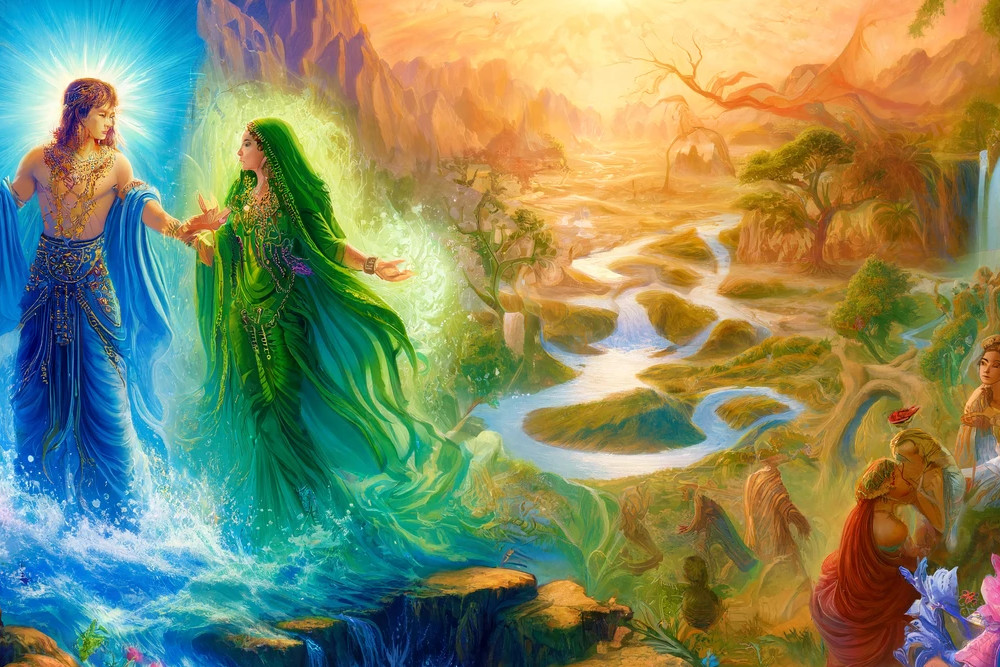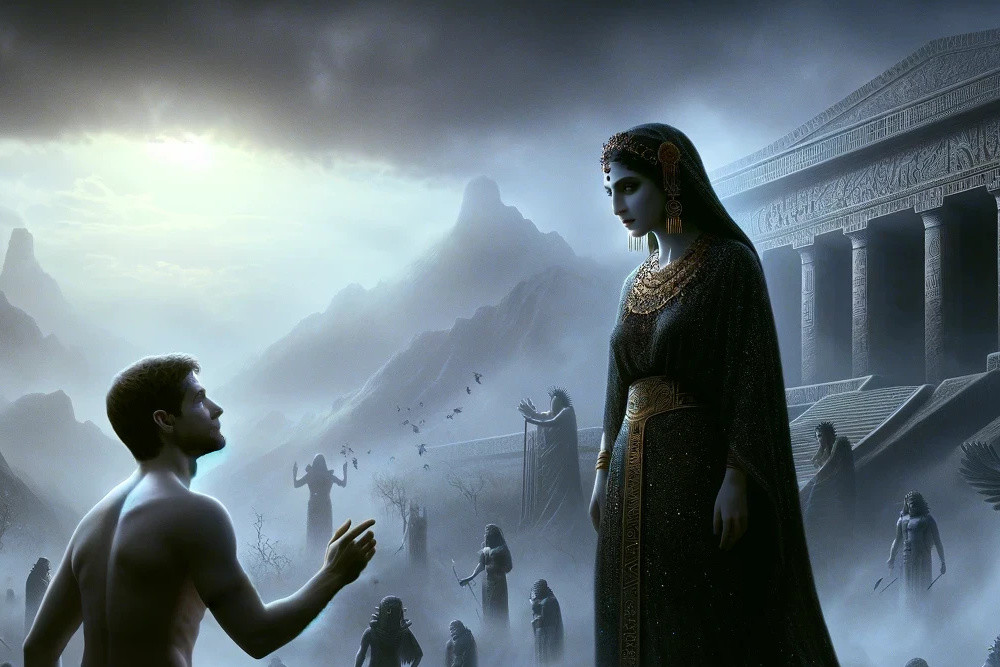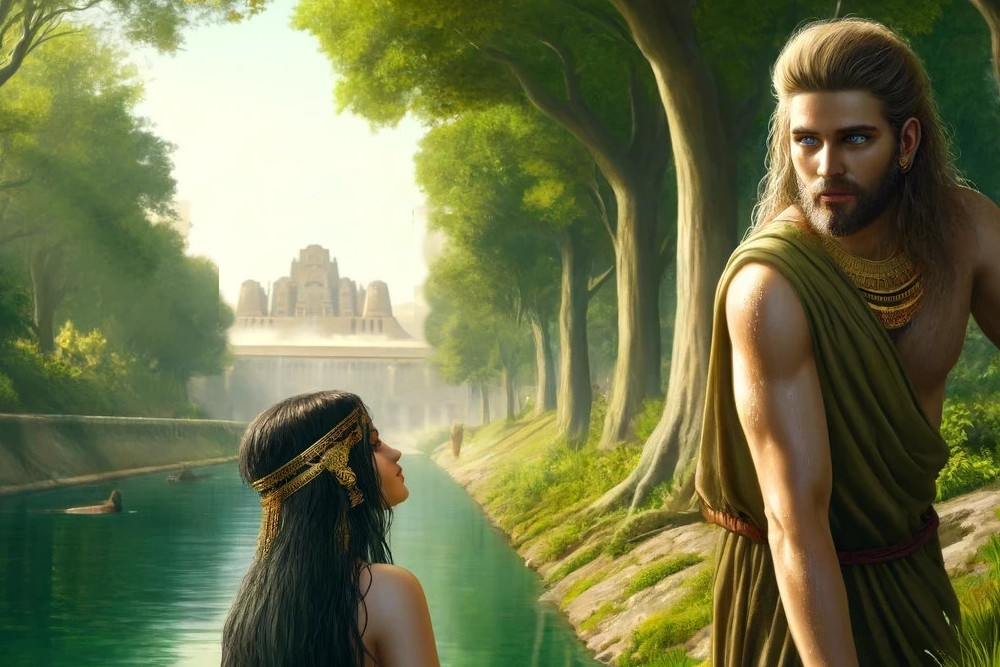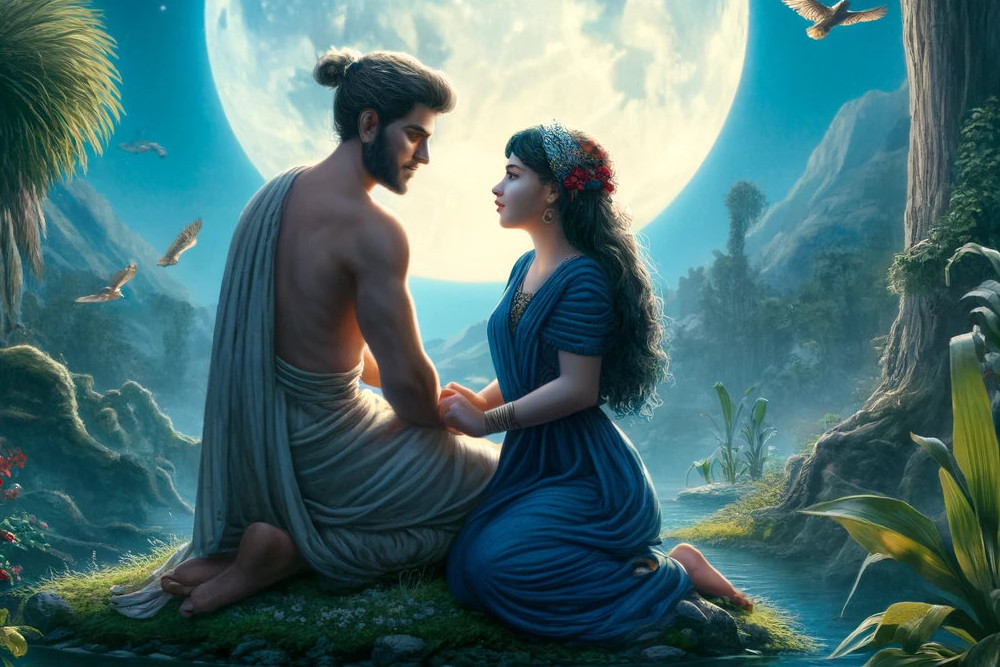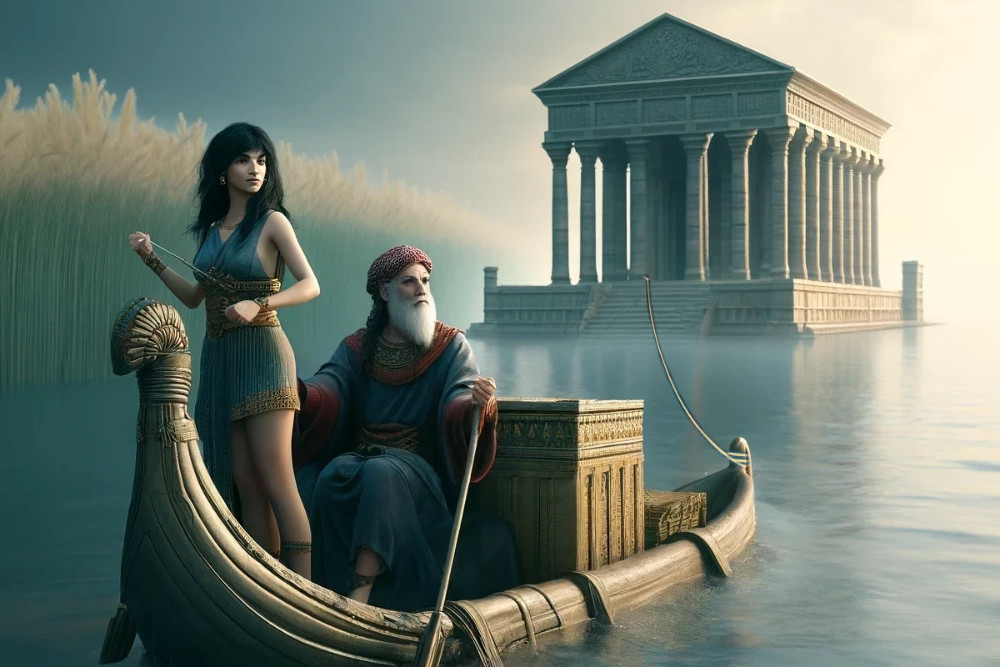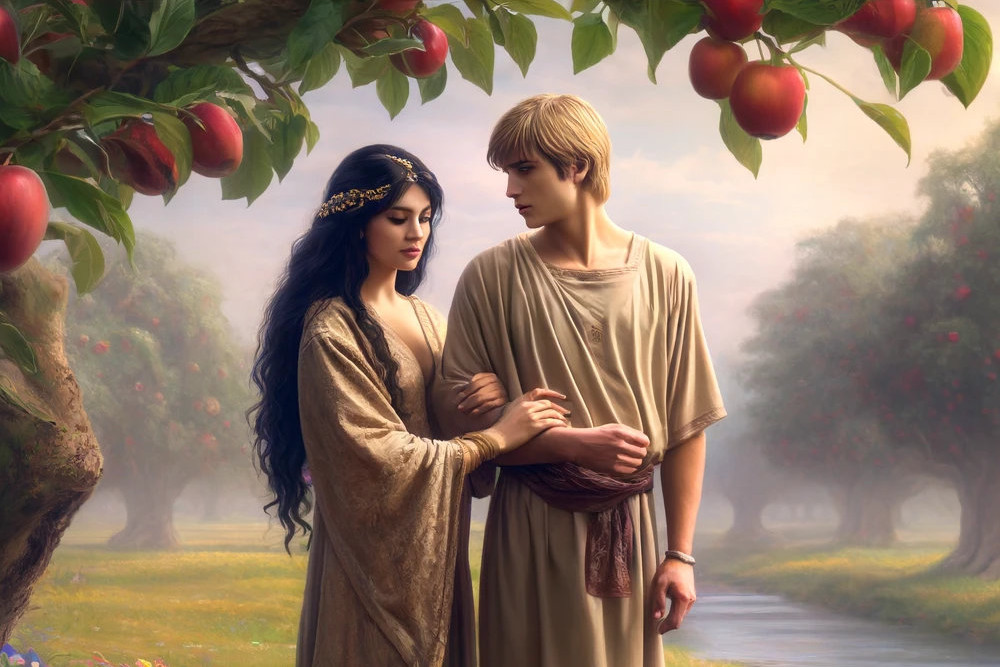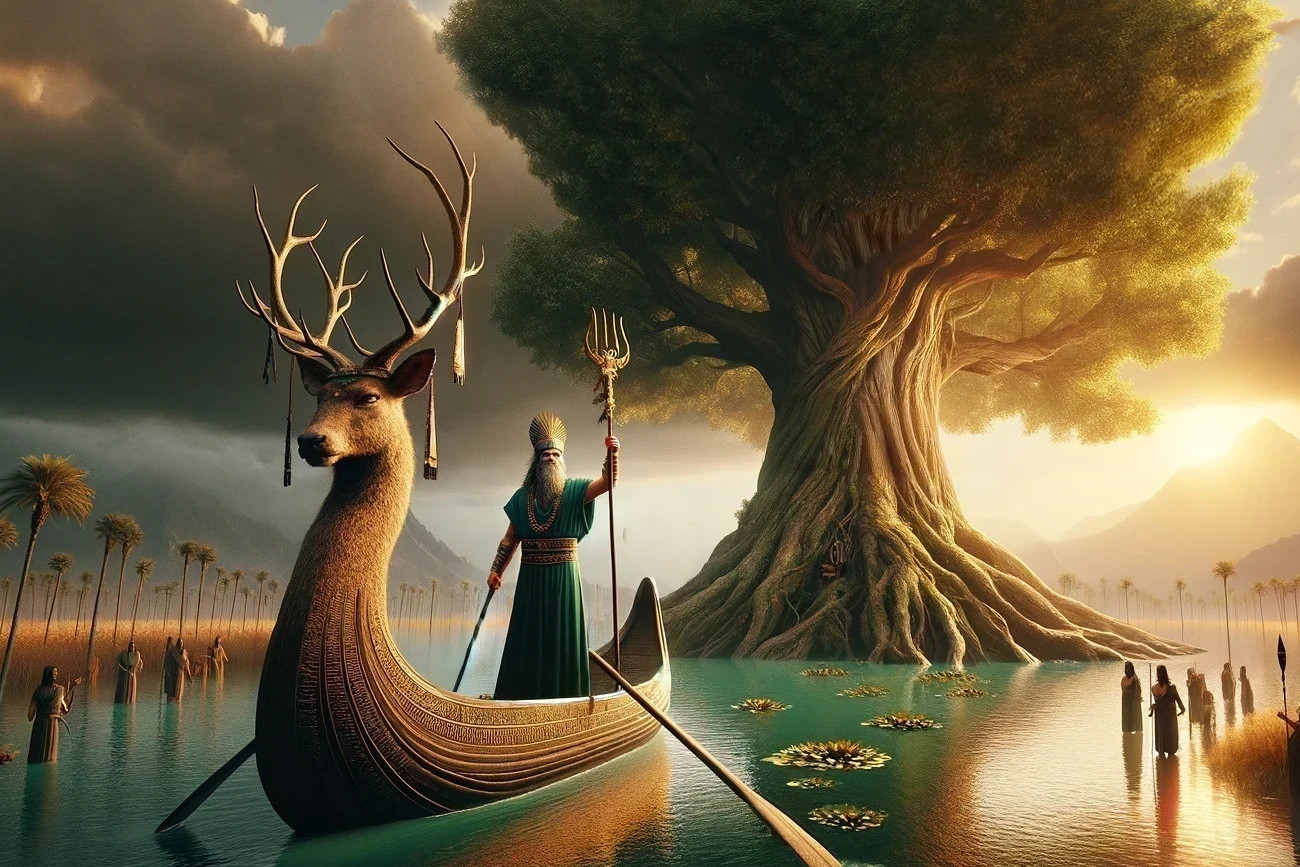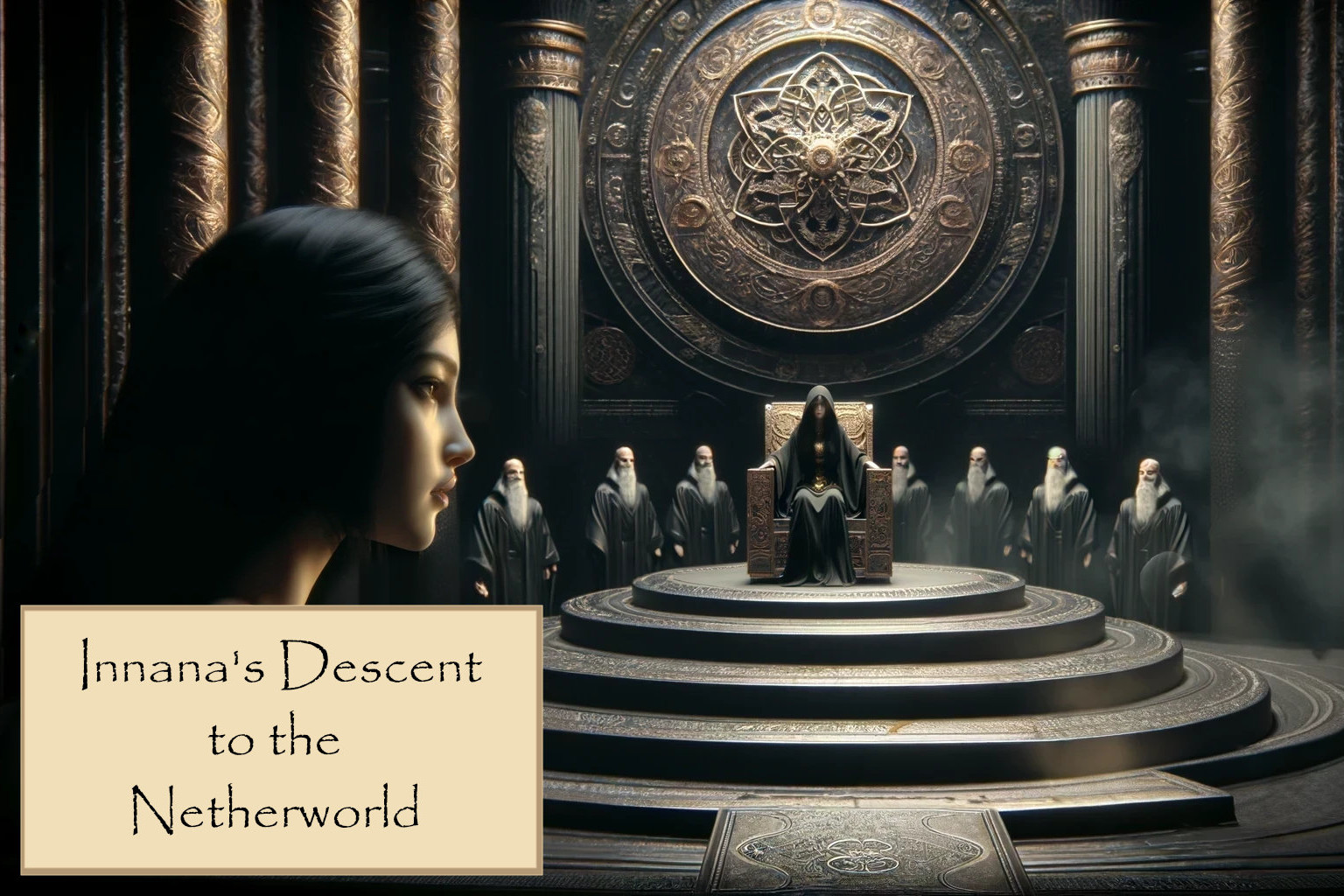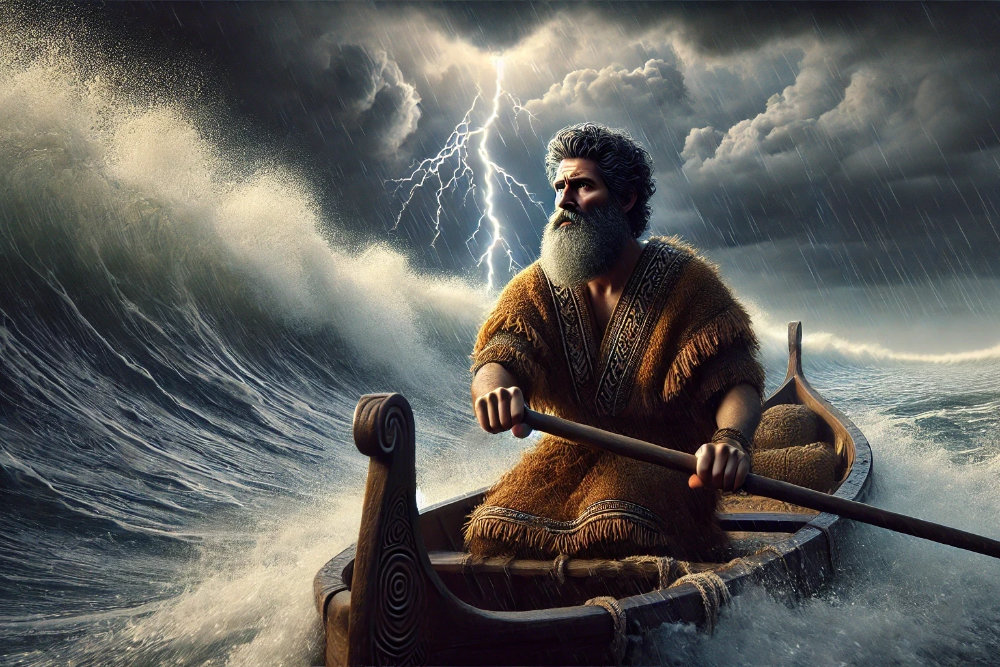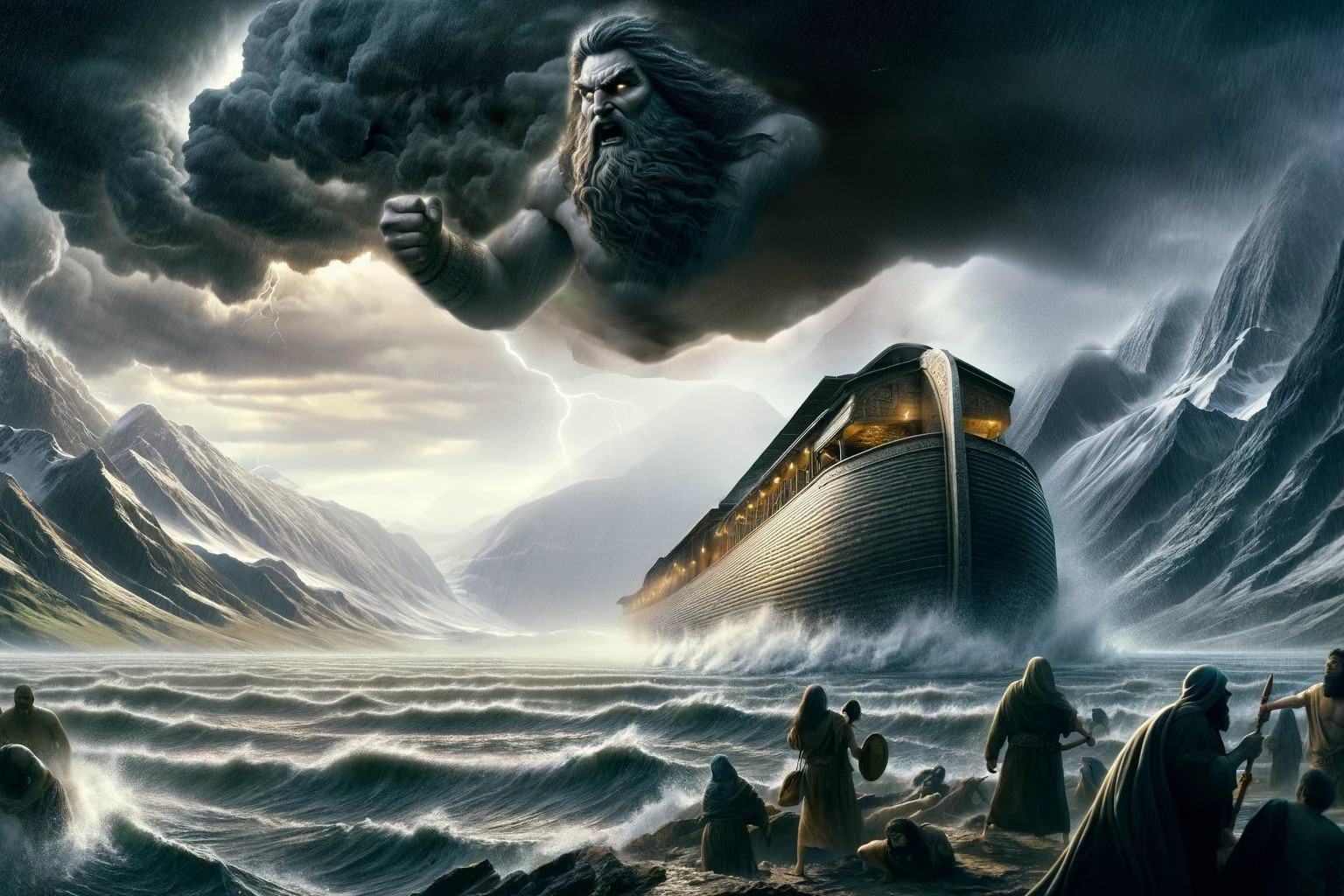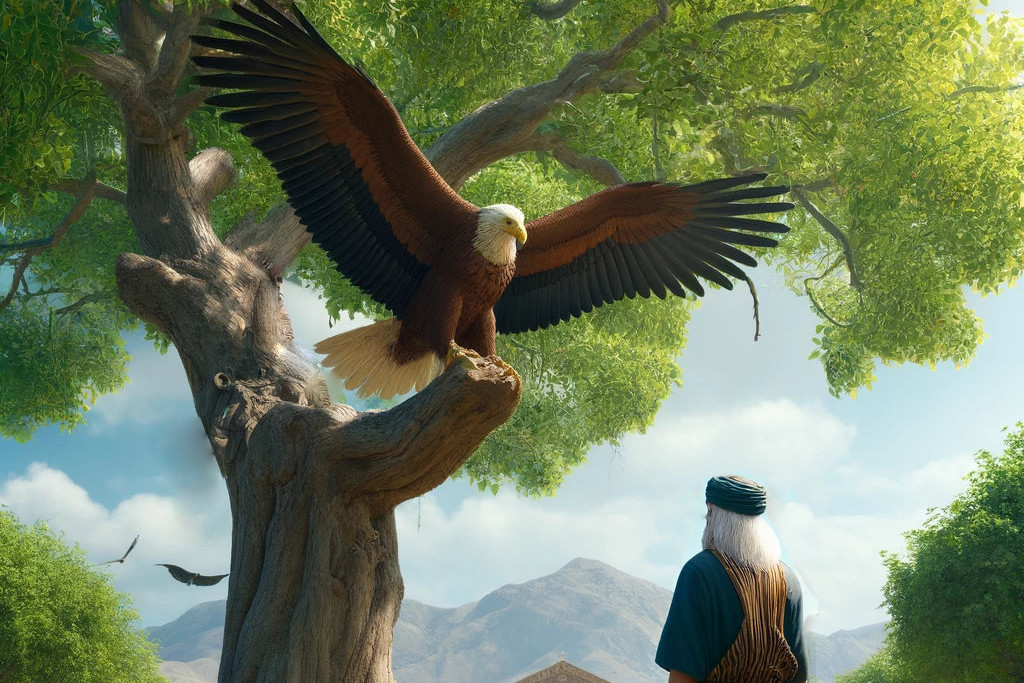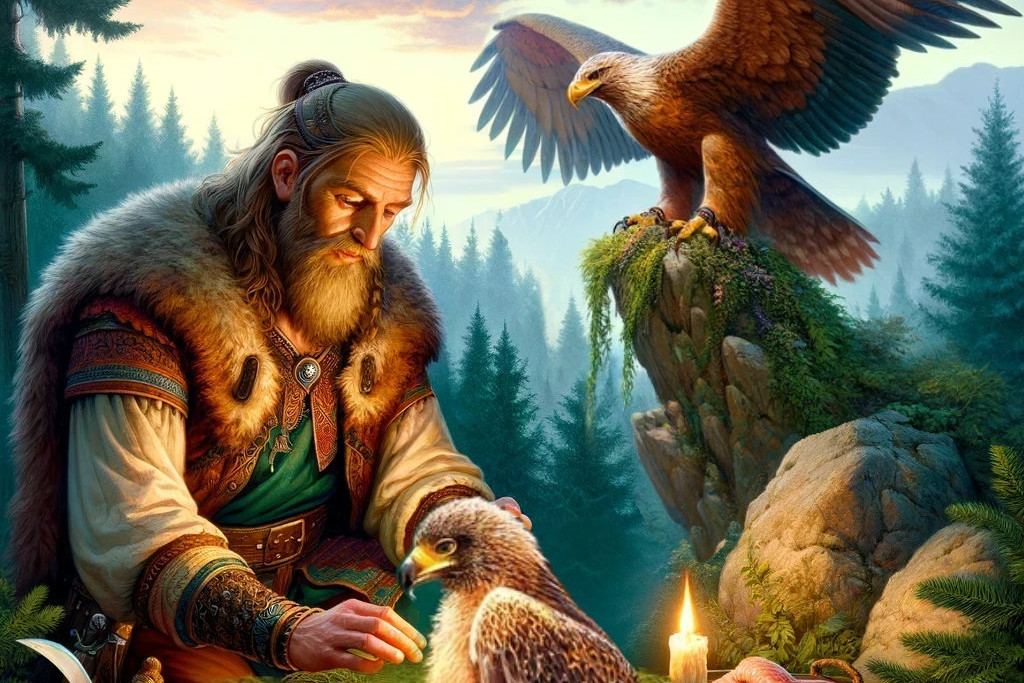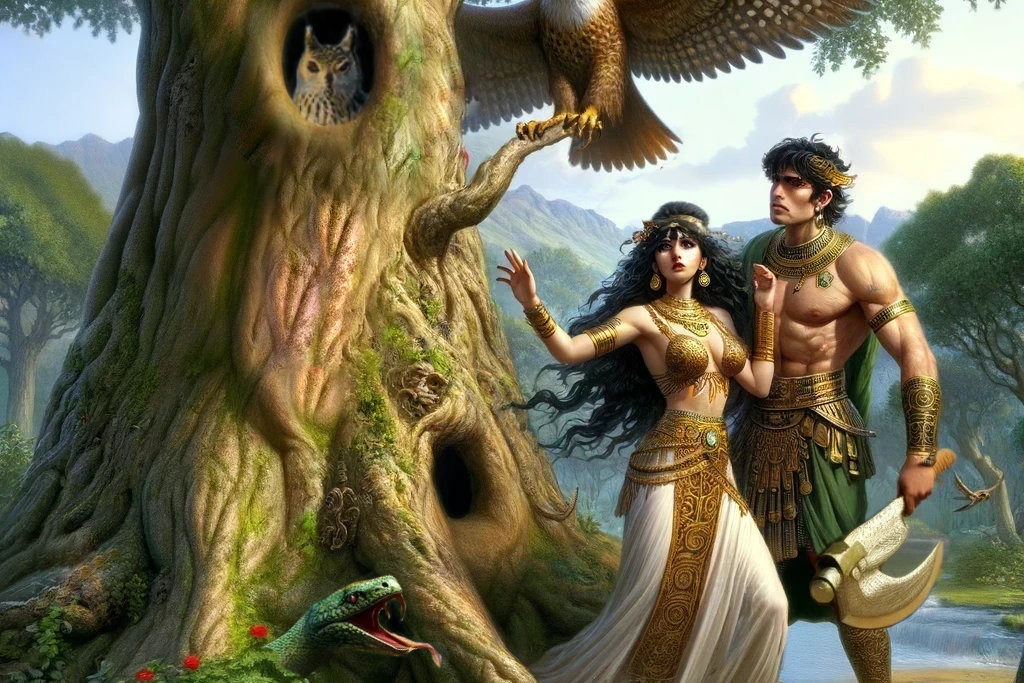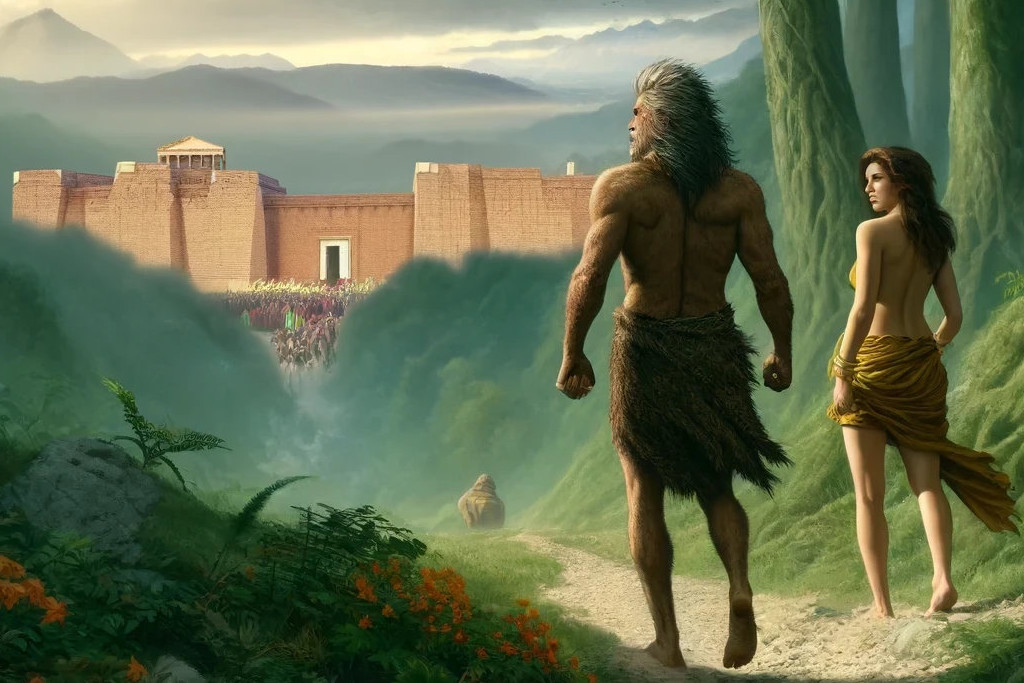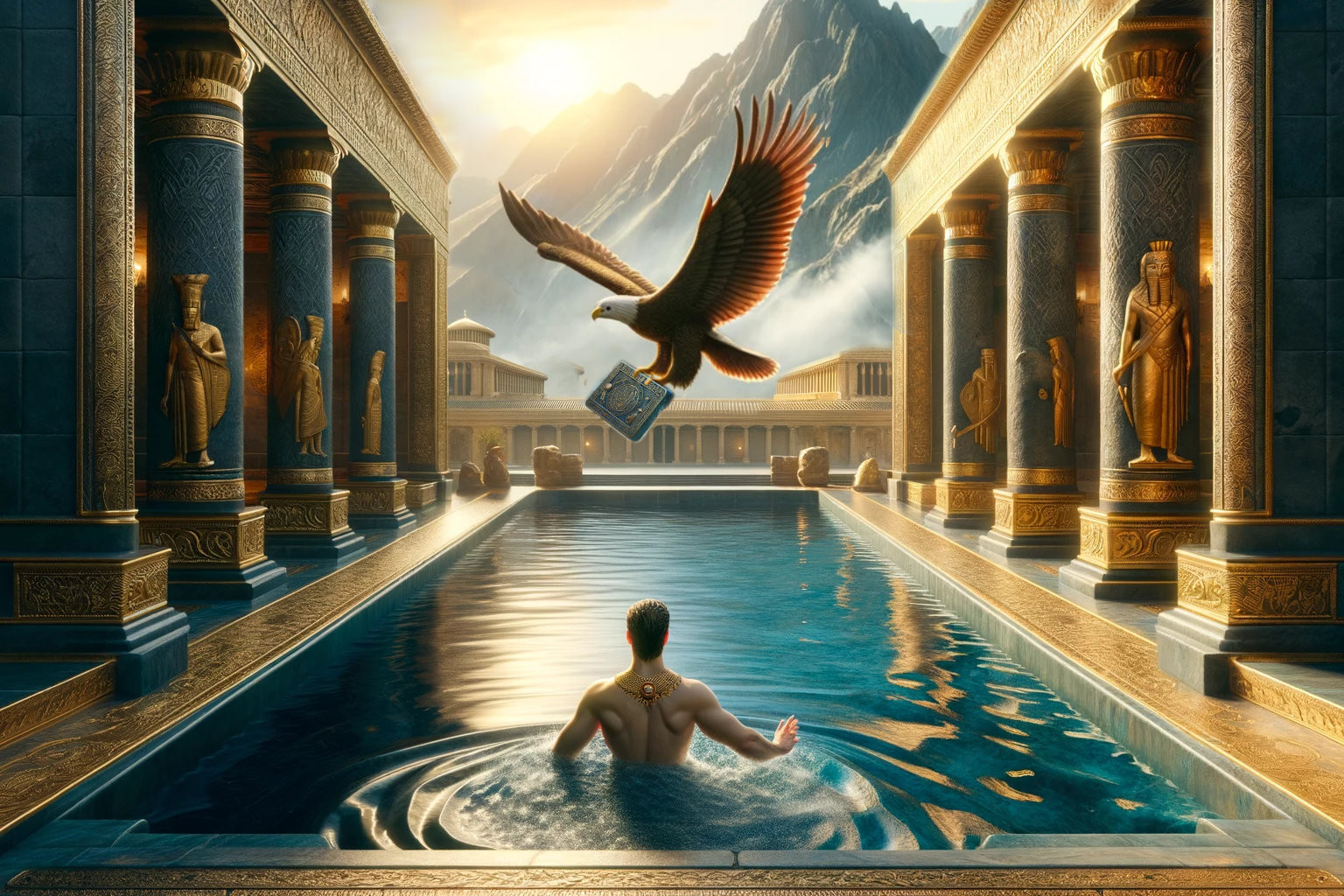Enki and Ninhursag (5500 BCE)
The myth is a divine love and creation story. Enki falls in love with Ninhursag and transforms the barren landscape of Dilmun into a fertile paradise. Ninhursag temporarily leaves Dilmun. After losing Ninhursag, the youthful Enki seduces all the young women in whom he believes he recognizes Ninhursag. However, he must realize each time that they do not equal her and leaves them again. Enki, who suffers illnesses as punishment for this, is restored through Ninhursag’s healing powers. The myth ends with their reconciliation and the strengthening of their love.
Enki and Ereshkigal (5400 BCE)
The myth tells the story of Enki’s deep connection to his twin sister Ereshkigal, who has disappeared into the netherworld. Enki decides to descend into the netherworld to bring Ereshkigal back. However, he recognizes that Ereshkigal has chosen her role as ruler of the netherworld. Enki accepts her decision and receives from her the seed of the Huluppu tree as a sign of their enduring connection. This mighty tree, which grows near Eridu from a seed from the netherworld, henceforth embodies the continuing connection of his world with the netherworld and heaven.
Enlil and Ninlil (4900 BCE)
The myth tells the love story between the god Enlil and the young goddess Ninlil. Ninlil bathes in the city canal and Enlil approaches her. Ninlil initially rejects his advances, as this would have consequences for her due to her young age. Enlil reorders Ninlil’s fate so that she gains maturity. He then seduces her. However, Enlil was not permitted to alter Ninlil’s fate, which is why the other gods cause him to visit the underworld. While Enlil is on his way to the underworld, he has Ninlil conceive several gods who allow him to alter the fate decreed for him.
Ninurta and the Turtle (4100 BCE)
In the myth no turtle actually appears. The myth takes place at a time when the eagle Anzu was still young. Back then, Anzu had stolen the Tablet of Destinies for the first time, with which the fates of the Igigi can be decreed. The warrior Ninurta, who is himself an Igigi, succeeds in taking the tablet back from Anzu. He receives from Enki the task of ensuring that Anzu cannot steal it a second time. For him to succeed in this, some changes must be made to Ninurta’s consciousness, during which Ninurta receives his most important weapon, the Šarur mace.
Nanna and Ningal (4000 BCE)
The myth tells the love story between the moon god Nanna and the dream interpreter Ningal. Nanna is described as a luminous, renewing force that synchronizes the rhythm of life on earth with the cosmic cycles of the moon. Ningal, raised in the swamps near Eridu, is deeply connected with nature. She falls in love with Nanna, whose nightly appearance she regularly follows and who deeply touches her. The myth describes how Ningal and Nanna discover their love for each other and, despite initial secrecy, finally find their way to each other openly.
Inanna and An (3900 BCE)
The myth exists only fragmentarily. It tells how Inanna brought the temple of heaven, E-ana, from heaven to earth to claim it for herself. Despite the initial rejection by An, the sky god, who had bound his power to this temple, Inanna puts her plan into action with the support of her brother Utu. Inanna travels by boat, accompanied by Adabgir, the fisherman. Finally, with the help of Utu, Inanna safely brings the E-ana to earth to the newly founded city of Uruk. Through this act, Inanna establishes her power and becomes the city goddess of Uruk.
Inanna and Enki (3500 BCE)
In the myth, Inanna undertakes a journey to Eridu to obtain the divine powers, the Me, from Enki. During a boisterous celebration, the enchantingly beautiful Inanna manages to persuade the drunken Enki to give her the divine powers. After Enki has slept off his intoxication, he tries in vain to retrieve the divine powers. However, Inanna succeeds in bringing the divine powers safely to Uruk. Possession of these powers gives her permission to introduce fundamental aspects of human culture in Uruk. Enki ultimately accepts Inanna’s success.
The Courtship of Inanna and Dumuzi (3400 BCE)
The myth presents Inanna as an attractive young woman who loves to be seduced and desired. Instead of thinking about housework, she always thinks only of one thing. She chose the shepherd Dumuzi as her future husband and king of Uruk. Dumuzi was pleased with his assignment. Inanna assured him of support. She appointed herself as his leader in battle and his advocate in assemblies. Soon Inanna recognized that Dumuzi was ready for the sacred rites. The sacred marriage, which many kings after him would spend with Inanna, took place in the temple.
Enki and the World Order (3350 BCE)
The myth portrays Enki as a central god responsible for establishing social order. Enki is depicted as a powerful and revered god whose actions ensure the prosperity of Sumer. It is recalled that Enki planted the Huluppu tree in Eridu, which has now ripe fruits. The myth describes how Enki, after a recent flooding of Eridu and Ur, undertakes various ship journeys to consolidate the land. Enki divides the tasks among the gods to regulate the various aspects of life. Thereupon Inanna complains that she was overlooked in the assignment of tasks.
Inanna’s Descent to the Netherworld (3300 BCE)
Inanna visits the netherworld and takes various divine powers with her to protect herself. When Inanna arrives at the gates, Ereshkigal learns of the divine powers. Ereshkigal instructs the gatekeeper to take all divine powers from her upon entry, whereby the powers transfer to Ereshkigal. Naked and without her divine powers, Inanna appears before Ereshkigal, whereupon she is condemned to death. Although Enki manages to save Inanna, someone must take her place. Inanna chooses the one who did not mourn for her, her husband Dumuzi.
The Adapa Myth (3300 BCE)
The myth tells of Adapa, a wise priest of Enki. One day, when he went fishing, a storm arose and the South Wind caused his boat to capsize. Adapa therefore broke the wings of the South Wind, causing the wind to stand still for a time. This angered the sky god An, who summons Adapa to him. Enki warns Adapa and advises him to refuse food and drink that An will offer him, as they would be deadly. When Adapa appears before An, he indeed refuses the offered food and water, although An said they would grant immortality. After the encounter, Adapa returns to earth.
The Atrahasis Epic (2900 BCE)
The epic addresses the creation of civilization. Initially, the Igigi perform the heavy labor. Overburdened by the hard work, they rebel. The supreme Anunnaki consult and Enki proposes to endow humans with intelligence so they can take over the work of the Igigi. Ninhursag puts it into action. Soon after, the population growth causes Enlil to first trigger a plague and then a drought. But after some time, the humans were as numerous as before. This time Enlil sends the great flood to finally exterminate humanity and begin anew.
The Etana Myth (2850 BCE)
The myth is designed as a riddle. It tells the story of Etana, the first king of Kish. Etana built a shrine in memory of the great flood, under whose protection stands the Huluppu tree. In the crown nests the eagle Anzu and at its root the serpent. Both swear an oath of friendship before the god Utu (Shamash), but the eagle breaks the oath. As punishment, Utu has him plucked and thrown into a pit. King Etana, who needs a successor, is instructed by Utu to save the eagle. In return, the eagle promises him the plant of life and carries him to heaven to the gods.
Lugalbanda and the Anzu Bird (2700 BCE)
The myth tells of the adventures of the hero Lugalbanda. To reach his troops, who are encamped before Aratta, he tries to win the favor of Anzu. He prepares a feast for his family, which deeply impresses Anzu. Anzu then offers him the choice of his fate. Lugalbanda chooses the ability to travel without fatigue. He uses this gift to reach his troops. When the siege drags on, he goes back to Uruk on Enmerkar’s behalf to ask Inanna for help. However, she demands sacrificial offerings that are difficult to obtain before she considers intervening in the conflict.
Inanna and the Huluppu Tree (2600 BCE)
During a flood, the Huluppu tree, which Enki once planted by the Euphrates, was swept away. Inanna saved it and planted it in her garden. But a serpent nested at the roots, the Anzu bird in the branches, and the dark maid Lilith in the trunk. When it was time to fell the tree, Inanna asked Gilgamesh for help. Gilgamesh killed the serpent, whereupon Anzu and Lilith fled. Together with the young men of the city, he felled the tree. Inanna built herself a bed and a throne from the wood, as well as a Pukku for Gilgamesh. When Gilgamesh played on his Pukku, the young men danced to it until they died of exhaustion.
The Gilgamesh Epic (2600 BCE)
The epic tells of the adventures of King Gilgamesh of Uruk. The gods create Enkidu, a wild man, to distract the tyrannical king. Enkidu befriends Gilgamesh and together they survive many adventures. Enkidu later dies of an illness considered punishment from the gods, which deeply shakes Gilgamesh and sends him on a quest for immortality. He meets Utnapishtim, the survivor of the flood, who was granted immortality by the gods. Gilgamesh learns that he too must find a god who will grant him immortality. However, this was not the fate that was destined for him.
The Anzu Myth (1900 BCE)
Anzu is commissioned by Enlil to guard the Tablet of Destinies, but he feels attracted to the power it confers. This tablet would enable him to establish the rites of the Igigi and determine their fates. One day, when Enlil is bathing, Anzu seizes the opportunity and flees with the Tablet of Destinies into the mountains. However, this brings chaos. Ninurta receives the task of taking the Tablet of Destinies from Anzu. In the battle that follows, Ninurta succeeds through cunning and the help of Enki (Ea) in overpowering Anzu. With Anzu’s death, Anzu’s duties pass to Ninurta.
